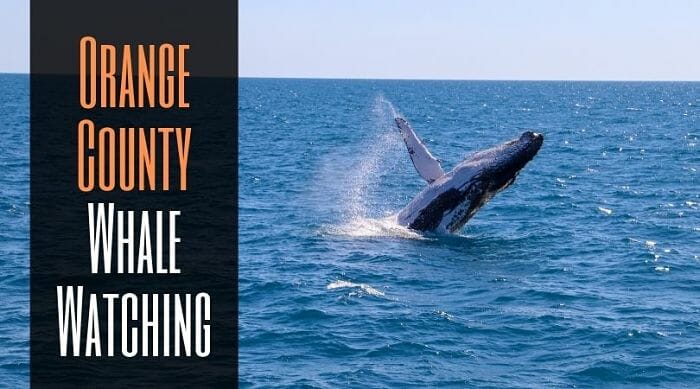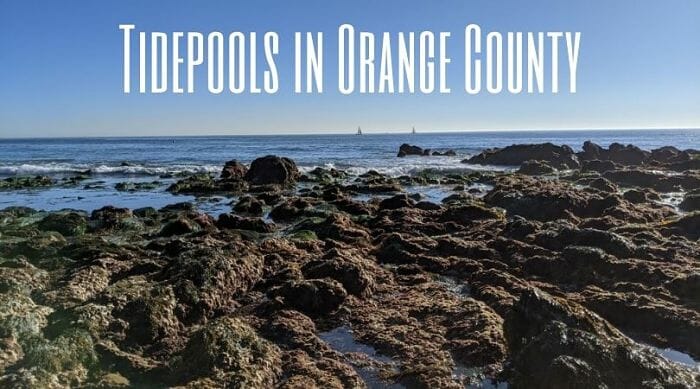We know that the Aquarium of the Pacific isn’t in Orange County proper, but it’s close enough in nearby Long Beach to be an easy drive from anywhere in the OC. So if you’re ready to get your sea-life fix in an elegant air-conditioned environment, keep reading. We’re about to tell you everything you need to know to have a great day at the Aquarium of the Pacific in Long Beach.
Welcome to the Aquarium of the Pacific
Housed in a blue glass building whose design echoes the rolling swells of the Pacific ocean and located on picturesque and popular Rainbow Harbor in Long Beach, the Aquarium of the Pacific is a world-class edutainment attraction that combines a relaxed local vibe with a local admission price and high-quality exhibits.
The Aquarium of the Pacific has something for everyone. If you’re Interested in marine conservation, if you’re an animal lover, a (budding) marine biologist, a salt water aquarium enthusiast… or if you have young children and want a safe, fun, educational space for them to indulge their wonder in the natural world, the Aquarium of the Pacific is an excellent half or full day trip.

The Aquarium isn’t the only draw in the area… the fabled Queen Mary and the Long Beach Convention Center are also within easy distance, giving Aquarium patrons access to events and additional museums in the area.
The Aquarium of the Pacific is unusually affordable, especially for an attraction of this caliber. There are a whole range of ticket prices, from single visit to a multi-tiered membership structure that’s engineered to flex around your needs… and your budget.
If you’re only looking to go once a year, buying tickets a la carte makes perfect sense. If you love going to the Aquarium and want to go on the regular, then a membership (with its discounts and perks) is clearly the way to go.
If you’re planning on visiting multiple attractions in the area, check out the Go City Tourist Pass for discounted rates, or try these other discount programs.
Pro-Tip: The Aquarium box office and website sells combination tickets that allow you to visit the LA Zoo, go on a harbor tour… even go behind the scenes at the Aquarium or go whale watching, all at a discounted price.
Pro-Tip: The Aquarium offers discounted homeschool days a few times a year. Home educators can purchase tickets online to attend these special days that feature hands-on activities and exhibits throughout the venue. Keep an eye on the calendar for the next available date.
Touring the Aquarium of the Pacific
Seen from the street, the Aquarium of the Pacific is a striking, modern building on the harbor, easily identifiable by its beautiful blue glass exterior.
Once you’re inside the building, the floor plan is just as extraordinary… strategically located exhibits around a soaring Great Hall and adjacent spaces.
Walking into the Aquarium’s 353,685 square foot facility is like walking into an underwater fantasyland. The Great Hall is light and airy, making it easy to see the details of the life-size blue whale model swimming through the air in the center of the space (climb the stairs for the upper level exhibits to get a closer look).
Fun Aquarium Fact: The floor plan looks like a whale. How’s that for theming?
But the whale is just the start….
The Aquarium of the Pacific houses over 500 species of marine animals in 50 exhibits. One of the most eye-catching exhibits is the 140,000 gallon Honda Blue Cavern, located at the far end of the Great Hall of the Pacific.
The Blue Cavern is a kelp forest habitat modeled after a real dive site in a kelp forest off the west side of Catalina Island, and it’s a fantastic way to start off a trip through the Aquarium.
The two-story habitat houses elegant leopard sharks, muscular giant sea bass, and fascinatingly intimidating California moray eels, among other sea life. Visitors can look up through the crystal-clear water to see the entirety of the tank… that’s the kind of view you can’t get unless you’re diving in an actual kelp forest.
Fun Aquarium Fact: The only giant sea bass successfully hatched in captivity is in the Aquarium of the Pacific.
Speaking of diving, the Blue Cavern habitat runs educational shows while staff divers hand-feed the animals. Divers can speak directly to the audience as they work, and it’s fascinating to watch the divers coordinate the different feeding stations so that every fish gets what they need.
Once you’ve oohed and ahhed over the Blue Cavern, it’s time to head into the rest of the exhibits.
Pro-Tip: The Aquarium of the Pacific has its own series of free apps, available on Google Play or the Apple AppStore, to help you get the most out of your visit. Go here (for Android) or here (for Apple) for the Aquarium Visitor Guide app, with links to an interactive map, fun activities, information on the Aquarium’s resident animals, and more.
There’s no one perfect way to tour… some folks go straight into the cool dark of the Southern California/Baja exhibit, with its dozens of small exhibits, some head for the very noticeable two story tank at the end of the Great Hall… and some veteran visitors head upstairs.
Pro-Tip: Since most visitors start their Aquarium visit at the Baja Exhibit on the first floor, you can usually beat the crowds by going to the second floor exhibits first.
How Long Does It Take to View the Aquarium of the Pacific?
There are so many exhibits packed into the Aquarium that listing them in one article would probably take as long as actually seeing them in person (which would be more fun, anyway), but we’re including some highlights for the best of the best.
The Aquarium isn’t too large, but it is packed with exhibits and things to do and see; it’ll take a few hours of your time to view the whole thing.
Besides the serene expanse of the Blue Cavern exhibit in the Great Hall, there are several touch labs where you can encounter marine animals in a safe but intimate setting (handicap accessible).
- Moon Jelly Touch Lab (first floor)
- Horseshoe Crab Touch Lab (first floor)
- Coastal Corner Touch Lab (second floor)
- Ray Habitat Touch Pool (second floor)
One of the most popular exhibits in the Aquarium is the Seal and Sea Lion Habitat. Walk through their world as you stroll through a glass tunnel and meet these beautiful animals on their own terms. Seals will often stop and get a closer look at visitors, especially kids. We’re never sure who’s more delighted by the meetings, the kids or the seals.
The Tropical Reef Exhibit – the largest single exhibit in the Aquarium at 350,000 gallons of carefully maintained water – is also incredibly popular for its colorful critters. If you’re looking for sea turtles or blacktip reef sharks, this is the spot you’re going to want to stake out.
The whimsical, beautiful, fragile leafy sea dragons are also in this section of the exhibit, and they’re well worth a look.
Can’t wait to see fantastic fish? Click here to check out the Aquarium’s Tropical Reef Webcam with its 24-hour a day live feed and you won’t have to.
The Aquarium Has More Than Fish
When you’re going to the Aquarium of the Pacific, you expect to see skates, rays, sharks… maybe some seals. Starfish? Definitely.
Birds? Not so much.
But you can see birds – specifically, Australian lorikeets and Guam kingfishers – in Lorikeet Forest. This walk-through aviary is the nature walk of your dreams, allowing you to stroll through a beautiful enclosed forest area and encounter these brightly colored birds.
Want a closer encounter? The resident lorikeets are smart and they’re quick to recognize when someone has something tasty for them. Purchase a cup of nectar and feed the birds that roam the habitat. Who knows… you might end up with a lorikeet or three perched on your arm – or head!
Sensory Warning: The Lorikeet forest is a loud environment with a lot of birds making a variety of high-pitched screeches, squeaks, squawks, and other calls. If you or your child has auditory processing issues, you may want to take hearing protection, or skip the exhibit altogether.
Tips for Parents
Travelling with small children means two things… food breaks and bathroom trips, and a lot of them. The Aquarium of the Pacific has plenty of resources for both needs.
Pro-Tip: Bathrooms are located in the central and rear areas of the building on both floors, and child-care stations are available in the bathrooms. You’re never too far away from a restroom!
For hungry kids, there are two choices: Bamboo Bistro on the first floor and Café Scuba on the second. Café Scuba’s our personal choice – it serves a good variety of food and has a great view of the seals and sea lion tank. Your kids will be so busy watching the animals, they might forget to eat!
Please note that outside food isn’t allowed inside the Aquarium, but that there’s a lovely picnic area outside that you can use to munch on your home-brought goodies. There’s also an ocean-themed playground with plenty of seating for parents who want to watch their kids clamber all over the giant water-squirting sculptures.
Special Needs Resources at the Aquarium of the Pacific
The Aquarium welcomes ADA-compliant service dogs. Aquarium staff can also provide wheelchairs as needed for guests with mobility concerns.
The Aquarium of the Pacific works hard to make sure that guests of all ages and abilities can enjoy their exhibits. Ask at the desk for accommodations for the blind, deaf, or mobility impaired. Wheelchairs, sign language interpreters, sensory-enhanced productions in the movie theater, and closed-captioned videos are just the tip of the iceberg. Check here for more information.
The Aquarium of the Pacific Supports an Autism Friendly Environment
Parents of kids on the spectrum know that overloads happen. The Aquarium can be a noisy place, especially on popular days. Luckily, the Aquarium staff knows that, too… and they made sure to arrange days when people with sensory issues could visit in comfort. Check the Aquarium of the Pacific website to see when the next Autism Families Nights and Morning is scheduled and enjoy the exhibits in a low-intensity, sensory-friendly setting.
We could go on and on about how amazing, valuable, friendly and fun the Aquarium of the Pacific is… but honestly, you’d probably rather go check it out yourself, right?
Frequently Asked Questions
How to Get to the Aquarium of the Pacific
The Aquarium is located at 100 Aquarium Way, Long Beach, CA 90802. It’s an easy jaunt up the 405 North to the 710 South if you’re coming in from Orange County. It’s also accessible through public transit. How handy is that?
Pro-Tip: The Aquarium is a 10-minute walk from the Transit Mall on Pine and 1st or take the Passport bus (it’s free!) Using Metro’s Trip Advisor will help you get where you’re going, however you choose to get there.
Where Do I Park?
The Aquarium of the Pacific has its own dedicated and very distinctive parking structure. Parking there also gives you easy access to The Pike and Shoreline Village and the vibrant shopping and restaurant scene there. The parking structure is located on the water side of Shoreline Drive. Look for it between Chestnut Place and Aquarium Way.
Parking fees are only $8 a day with Aquarium validation, so it’s easy to turn your Aquarium trip into a day destination, complete with sightseeing and dinner.
So if you’re looking for something to do around Orange County, and you don’t mind going a little further into Long Beach, why not check out the Aquarium of the Pacific? After all… who says you have to go to the beach to see fish?
Aquarium Academy: Online Resources
The Aquarium of the Pacific has launched online virtual programming for both kids and adults. For kids, enjoy interactive live stream programs with aquarium educators and find online exhibits to explore, wildlife webcams, activity and coloring pages, YouTube programs and more. Adults can view the guest speaker series featuring aquarium staff, artists, scientists, and more, plus access Aquatic Academy courses to learn about issues affecting our Ocean Planet.
Related Articles
| Family Attractions in Orange County | Disneyland |
| Knotts Berry Farm | Disney’s California Adventure |
| Best Tidepools in Orange County | How To Get a Hotel Day Pass |




